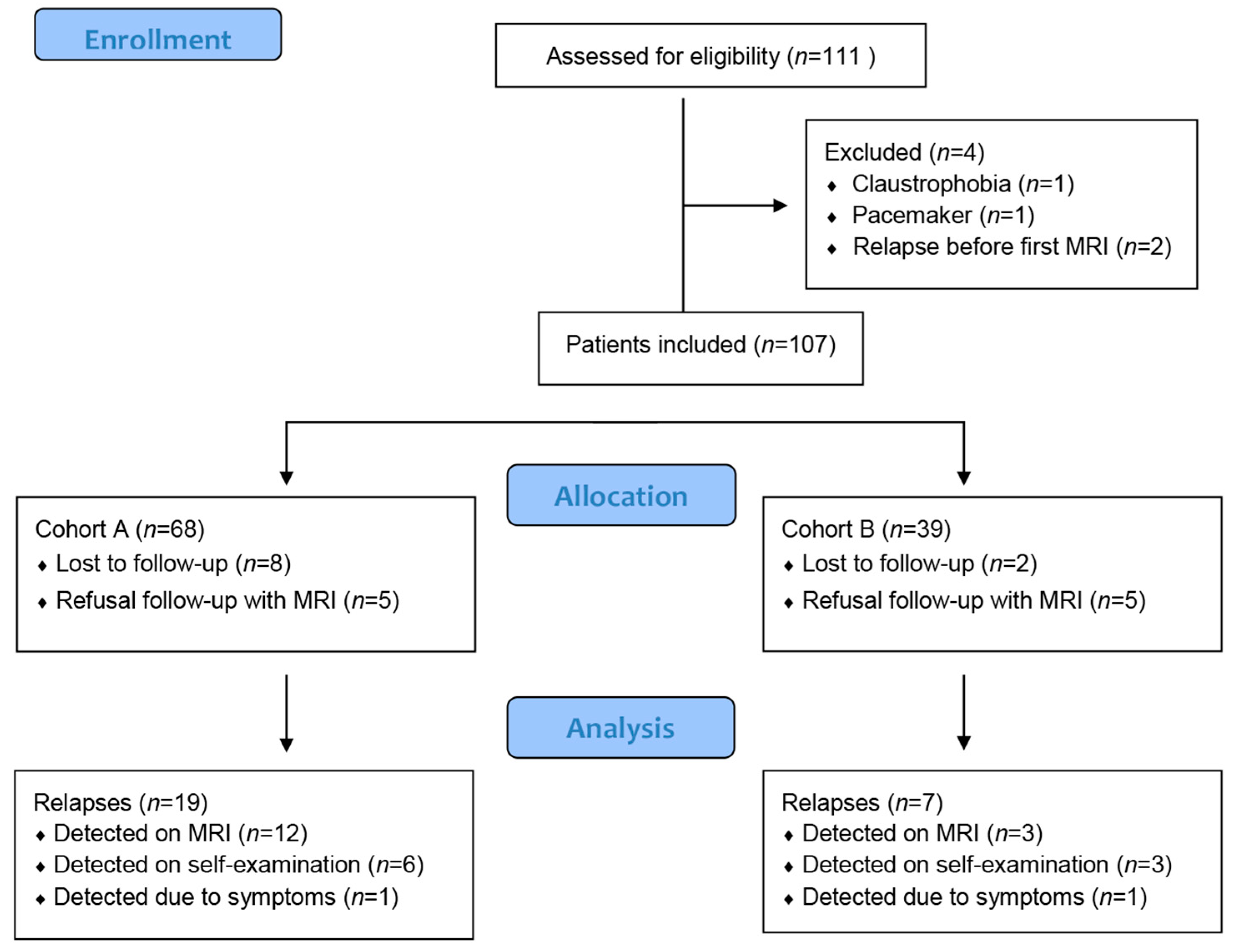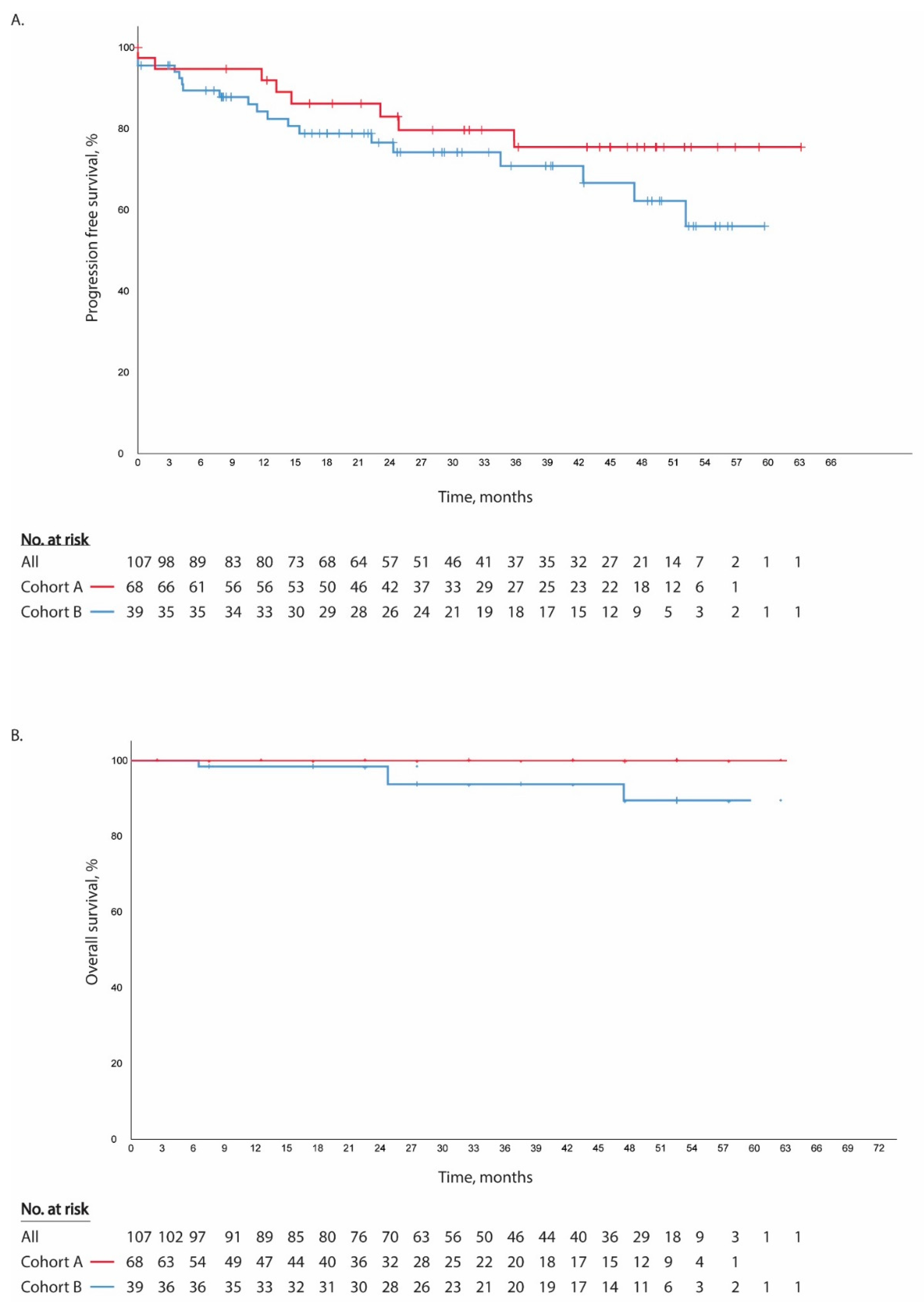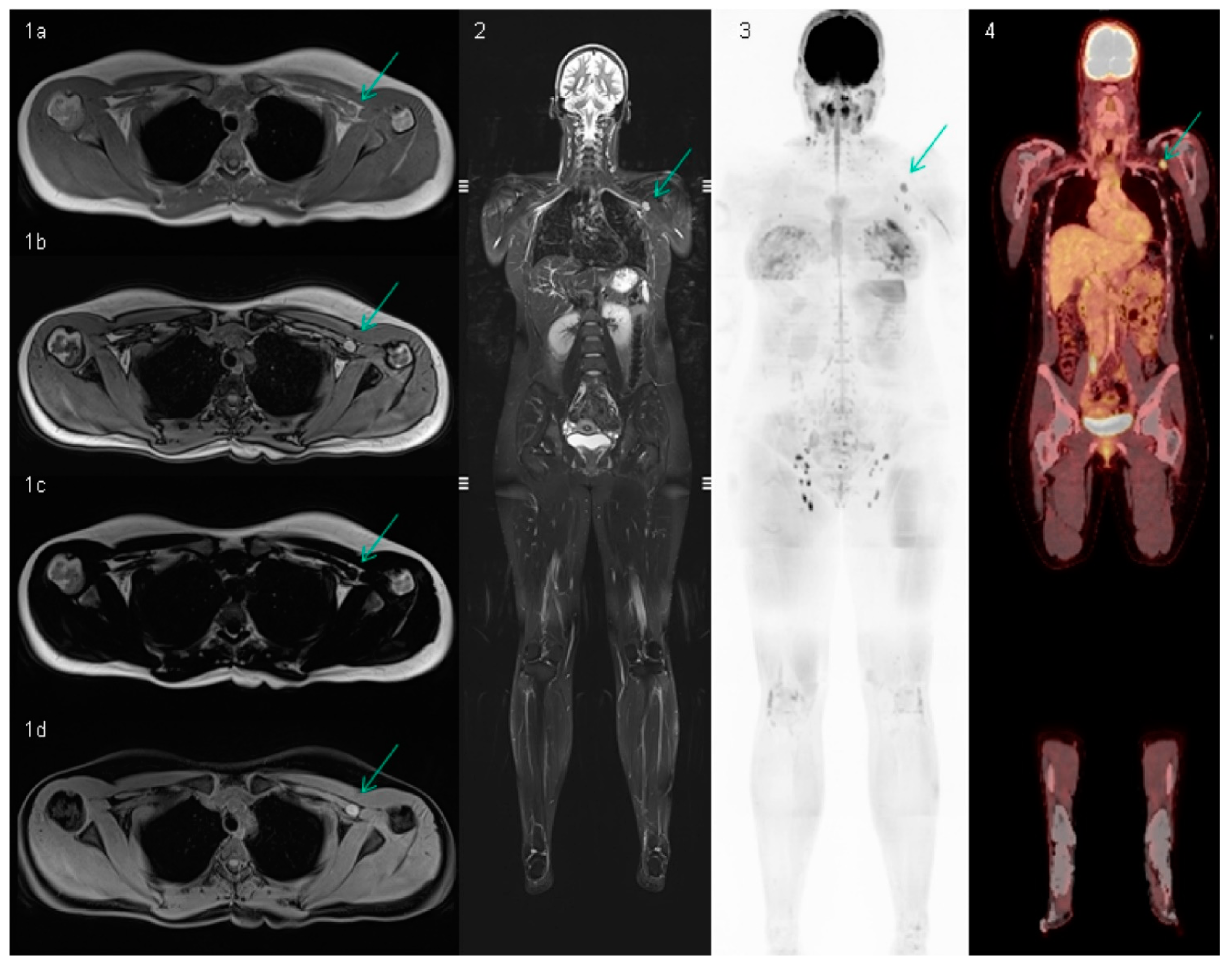Whole-Body MRI for the Detection of Recurrence in Melanoma Patients at High Risk of Relapse
Abstract
Simple Summary
Abstract
1. Introduction
2. Material and Methods
2.1. Study Design and Patients
2.2. Imaging Protocols
2.3. Imaging Analyses
2.4. Definition and Study Endpoints
2.5. Statistical Analyses
3. Results
3.1. Patients Demographic
3.2. Relapses
3.3. Whole-Body MRI Performance
3.4. Outcome after Recurrence for Cohort A
3.5. Outcome after Recurrence for Cohort B
4. Discussion
5. Conclusions
Author Contributions
Funding
Institutional Review Board Statement
Informed Consent Statement
Data Availability Statement
Acknowledgments
Conflicts of Interest
Abbreviations
| CR | complete response |
| OS | overall survival |
| RFS | Recurrence-free survival |
| FN | false negative |
| FP | false positive |
| PR | partial response |
| TP | true positive |
| TN | true negative |
| AJCC-7 | American Joint Committee on Cancer Staging Manual seventh edition |
| LDH | lactate dehydrogenase |
| CRP | C-reactive protein |
| CT | computer tomography |
| PET/CT | positron emission tomography |
| BOR | best objective response |
References
- Romano, E.; Scordo, M.; Dusza, S.W.; Coit, D.G.; Chapman, P.B. Site and Timing of First Relapse in Stage III Melanoma Patients: Implications for Follow-up Guidelines. J. Clin. Oncol. 2010, 28, 3042–3047. [Google Scholar] [CrossRef] [PubMed]
- Read, R.L.; Madronio, C.M.; Cust, A.E.; Goumas, C.; Watts, C.G.; Menzies, S.; Curtin, A.M.; Mann, G.; Thompson, J.F.; Morton, R.L. Follow-up Recommendations after Diagnosis of Primary Cutaneous Melanoma: A Population-Based Study in New South Wales, Australia. Ann. Surg. Oncol. 2018, 25, 617–625. [Google Scholar] [CrossRef] [PubMed]
- Long, G.V.; Hauschild, A.; Santinami, M.; Atkinson, V.; Mandal, M.; Chiarion-Sileni, V.; Larkin, J.; Nyakas, M.; Dutriaux, C.; Haydon, A.; et al. Adjuvant Dabrafenib plus Trametinib in Stage III BRAF-Mutated Melanoma. N. Engl. J. Med. 2017, 377, 1813–1823. [Google Scholar] [CrossRef] [PubMed]
- Weber, J.; Mandala, M.; Del Vecchio, M.; Gogas, H.J.; Arance, A.M.; Cowey, C.L.; Dalle, S.; Schenker, M.; Chiarion-Sileni, V.; Marquez-Rodas, I.; et al. Adjuvant Nivolumab versus Ipilimumab in Resected Stage III or IV Melanoma. N. Engl. J. Med. 2017, 377, 1824–1835. [Google Scholar] [CrossRef] [PubMed]
- Francken, A.B.; Bastiaannet, E.; Hoekstra, H.J. Follow-up in Patients with Localised Primary Cutaneous Melanoma. Lancet Oncol. 2005, 6, 608–621. [Google Scholar] [CrossRef]
- Kaufman, H.; Amatruda, T.; Nemunaitis, J.J.; Chesney, J.A.; Delman, K.A.; Spitler, L.E.; Collichio, F.A.; Ross, M.I.; Zhang, Y.; Shilkrut, M.; et al. Tumor Size and Clinical Outcomes in Melanoma Patients (MEL Pts) Treated with Talimogene Laherparepvec (T-VEC). J. Clin. Oncol. 2015, 33 (Suppl. 15), 9074. [Google Scholar] [CrossRef]
- Joseph, R.W.; Elassaiss-Schaap, J.; Kefford, R.; Hwu, W.J.; Wolchok, J.D.; Joshua, A.M.; Ribas, A.; Hodi, F.S.; Hamid, O.; Robert, C.; et al. Baseline Tumor Size Is an Independent Prognostic Factor for Overall Survival in Patients with Melanoma Treated with Pembrolizumab. Clin. Cancer Res. 2018, 24, 4960–4967. [Google Scholar] [CrossRef]
- Menzies, A.M.; Haydu, L.E.; Carlino, M.S.; Azer, M.W.F.; Carr, P.J.A.; Kefford, R.F.; Long, G.V. Inter- And Intra-Patient Heterogeneity of Response and Progression to Targeted Therapy in Metastatic Melanoma. PLoS ONE 2014, 9, e85004. [Google Scholar] [CrossRef]
- Long, G.V.; Flaherty, K.T.; Stroyakovskiy, D.; Gogas, H.; Levchenko, E.; de Braud, F.; Larkin, J.; Garbe, C.; Jouary, T.; Hauschild, A.; et al. Dabrafenib plus Trametinib versus Dabrafenib Monotherapy in Patients with Metastatic BRAF V600E/K-Mutant Melanoma: Long-Term Survival and Safety Analysis of a Phase 3 Study. Ann. Oncol. 2017, 28, 1631–1639. [Google Scholar] [CrossRef]
- Pires da Silva, I.; Lo, S.; Quek, C.; Gonzalez, M.; Carlino, M.S.; Long, G.V.; Menzies, A.M. Site-specific Response Patterns, Pseudoprogression, and Acquired Resistance in Patients with Melanoma Treated with Ipilimumab Combined with Anti-PD-1 Therapy. Cancer 2019, 126, 86–97. [Google Scholar] [CrossRef]
- Tsur, N.; Kogan, Y.; Avizov-Khodak, E.; Vaeth, D.; Vogler, N.; Utikal, J.; Lotem, M.; Agur, Z. Predicting Response to Pembrolizumab in Metastatic Melanoma by a New Personalization Algorithm. J. Transl. Med. 2019, 17, 338. [Google Scholar] [CrossRef] [PubMed]
- Daud, A.I.; Wolchok, J.D.; Robert, C.; Hwu, W.J.; Weber, J.S.; Ribas, A.; Hodi, F.S.; Joshua, A.M.; Kefford, R.; Hersey, P.; et al. Programmed Death-Ligand 1 Expression and Response to the Anti-Programmed Death 1 Antibody Pembrolizumab in Melanoma. J. Clin. Oncol. 2016, 34, 4102–4109. [Google Scholar] [CrossRef] [PubMed]
- Robert, C.; Long, G.V.; Brady, B.; Dutriaux, C.; Maio, M.; Mortier, L.; Hassel, J.C.; Rutkowski, P.; McNeil, C.; Kalinka-Warzocha, E.; et al. Nivolumab in Previously Untreated Melanoma without BRAF Mutation. N. Engl. J. Med. 2015, 372, 320–330. [Google Scholar] [CrossRef]
- Zernhelt, A.M.; Schadendorf, D.; Kang, S.P.; Ebbinghaus, S.; O’Day, S.J.; Li, X.N.; Goldinger, S.M.; Salama, A.K.S.; Margolin, K.A.; Moschos, S.J.; et al. Pembrolizumab versus Investigator-Choice Chemotherapy for Ipilimumab-Refractory Melanoma (KEYNOTE-002): A Randomised, Controlled, Phase 2 Trial. Lancet Oncol. 2015, 16, 908–918. [Google Scholar] [CrossRef]
- Wolchok, J.D.; Chiarion-Sileni, V.; Gonzalez, R.; Rutkowski, P.; Grob, J.-J.; Cowey, C.L.; Lao, C.D.; Wagstaff, J.; Schadendorf, D.; Ferrucci, P.F.; et al. Overall Survival with Combined Nivolumab and Ipilimumab in Advanced Melanoma. N. Engl. J. Med. 2017, 377, 1345–1356. [Google Scholar] [CrossRef] [PubMed]
- Topalian, S.L.; Sznol, M.; McDermott, D.F.; Kluger, H.M.; Carvajal, R.D.; Sharfman, W.H.; Brahmer, J.R.; Lawrence, D.P.; Atkins, M.B.; Powderly, J.D.; et al. Survival, Durable Tumor Remission, and Long-Term Safety in Patients with Advanced Melanoma Receiving Nivolumab. J. Clin. Oncol. 2014, 32, 1020–1030. [Google Scholar] [CrossRef] [PubMed]
- Jansen, Y.J.L.; Rozeman, E.A.; Mason, R.; Goldinger, S.M.; Geukes Foppen, M.H.; Hoejberg, L.; Schmidt, H.; van Thienen, J.V.; Haanen, J.B.A.G.; Tiainen, L.; et al. Discontinuation of Anti-PD-1 Antibody Therapy in the Absence of Disease Progression or Treatment Limiting Toxicity: Clinical Outcomes in Advanced Melanoma. Ann. Oncol. 2019, 30, 1154–1161. [Google Scholar] [CrossRef]
- Vilanova, J.C.; Barceló, J. Diffusion-Weighted Whole-Body MR Screening. Eur. J. Radiol. 2008, 67, 440–447. [Google Scholar] [CrossRef]
- Summers, P.; Padhani, A.; Petralia, G.; Bellomi, M.; Testori, A.; Raimondi, S.; Alessi, S. Whole-Body Diffusion-Weighted Imaging: Is It All We Need for Detecting Metastases in Melanoma Patients? Eur. Radiol. 2013, 23, 3466–3476. [Google Scholar] [CrossRef]
- Paruthikunnan, S.M.; Kadavigere, R.; Karegowda, L.H. Accuracy of Whole-Body Dwi for Metastases Screening in a Diverse Group of Malignancies: Comparison with Conventional Cross-Sectional Imaging and Nuclear Scintigraphy. Am. J. Roentgenol. 2017, 209, 477–490. [Google Scholar] [CrossRef]
- Müller-Horvat, C.; Radny, P.; Eigentler, T.K.; Schäfer, J.; Pfannenberg, C.; Horger, M.; Khorchidi, S.; Nägele, T.; Garbe, C.; Claussen, C.D.; et al. Prospective Comparison of the Impact on Treatment Decisions of Whole-Body Magnetic Resonance Imaging and Computed Tomography in Patients with Metastatic Malignant Melanoma. Eur. J. Cancer 2006, 42, 342–350. [Google Scholar] [CrossRef] [PubMed]
- Berzaczy, D.; Fueger, B.; Hoeller, C.; Haug, A.R.; Staudenherz, A.; Berzaczy, G.; Weber, M.; Mayerhoefer, M.E. Whole-Body [18F]FDG-PET/MRI vs. [18F]FDG-PET/CT in Malignant Melanoma. Mol. Imaging Biol. 2019, 22, 739–744. [Google Scholar] [CrossRef] [PubMed]
- Mosavi, F.; Ullenhag, G.; Ahlström, H. Whole-Body MRI Including Diffusion-Weighted Imaging Compared to CT for Staging of Malignant Melanoma. Upsala J. Med. Sci. 2013, 118, 91–97. [Google Scholar] [CrossRef]
- Jouvet, J.C.; Thomas, L.; Thomson, V.; Yanes, M.; Journe, C.; Morelec, I.; Bracoud, L.; Durupt, F.; Giammarile, F.; Berthezene, Y. Whole-Body MRI with Diffusion-Weighted Sequences Compared with 18 FDG PET-CT, CT and Superficial Lymph Node Ultrasonography in the Staging of Advanced Cutaneous Melanoma: A Prospective Study. J. Eur. Acad. Dermatol. Venereol. 2014, 28, 176–185. [Google Scholar] [CrossRef] [PubMed]
- Pflugfelder, A.; Kochs, C.; Blum, A.; Capellaro, M.; Czeschik, C.; Dettenborn, T.; Dill, D.; Dippel, E.; Eigentler, T.; Feyer, P.; et al. S3-Guideline “Diagnosis, Therapy and Follow-up of Melanoma”—Short Version. J. Dtsch. Dermatol. Ges. J. Ger. Soc. Dermatol. JDDG 2013, 11, 563–602. [Google Scholar] [CrossRef] [PubMed]
- Dummer, R.; Siano, M.; Hunger, R.E.; Lindenblatt, N.; Braun, R.; Michielin, O.; Mihic-Probst, D.; von Moos, R.; Najafi, Y.; Guckenberger, M.; et al. The Updated Swiss Guidelines 2016 for the Treatment and Follow-up of Cutaneous Melanoma. Swiss Med. Wkly. 2016, 146, w14279. [Google Scholar] [CrossRef][Green Version]
- Müller-Horvat, C.; Plathow, C.; Ludescher, B.; Lichy, M.P.; Canda, V.; Zindel, C.; Hahn, H.K.; Peitgen, H.-O.; Kuhnigk, J.; Claussen, C.D.; et al. Generating statements at whole-body imaging with a workflow-optimized software tool—First experiences with multireader analysis. Rofo 2007, 179, 721–727. [Google Scholar] [CrossRef]
- Hamid, O.; Robert, C.; Daud, A.; Hodi, F.S.; Hwu, W.J.; Kefford, R.; Wolchok, J.D.; Hersey, P.; Joseph, R.; Weber, J.S.; et al. Five-Year Survival Outcomes for Patients with Advanced Melanoma Treated with Pembrolizumab in KEYNOTE-001. Ann. Oncol. 2019, 30, 582–588. [Google Scholar] [CrossRef]
- Infante, M.; Cavuto, S.; Lutman, F.R.; Passera, E.; Chiarenza, M.; Chiesa, G.; Brambilla, G.; Angeli, E.; Aranzulla, G.; Chiti, A.; et al. Long-Term Follow-up Results of the DANTE Trial, a Randomized Study of Lung Cancer Screening with Spiral Computed Tomography. Am. J. Respir. Crit. Care Med. 2015, 191, 1166–1175. [Google Scholar] [CrossRef]
- Pedersen, J.H.; Ashraf, H.; Dirksen, A.; Bach, K.; Hansen, H.; Toennesen, P.; Thorsen, H.; Brodersen, J.; Skov, B.G.; DOøssing, M.; et al. The Danish Randomized Lung Cancer Ct Screening Trial-Overall Design and Results of the Prevalence Round. J. Thorac. Oncol. 2009, 4, 608–614. [Google Scholar] [CrossRef]
- Nieweg, O.E.; Kroon, B.B.R. The Conundrum of Follow-up: Should It Be Abandoned? Surg. Oncol. Clin. N. Am. 2006, 15, 319–330. [Google Scholar] [CrossRef] [PubMed]
- Schwarz, D.; Niederle, T.; Münch, P.; Hielscher, T.; Hassel, J.C.; Schlemmer, H.P.; Platten, M.; Winkler, F.; Wick, W.; Heiland, S.; et al. Susceptibility-Weighted Imaging in Malignant Melanoma Brain Metastasis. J. Magn. Reson. Imaging 2019, 50, 1251–1259. [Google Scholar] [CrossRef] [PubMed]
- Bottoni, U.; Clerico, R.; Paolino, G.; Ambrifi, M.; Corsetti, P.; Calvieri, S. Predictors and Survival in Patients with Melanoma Brain Metastases. Med. Oncol. 2013, 30, 466. [Google Scholar] [CrossRef] [PubMed]
- Tawbi, H.A.; Forsyth, P.A.; Algazi, A.; Hamid, O.; Hodi, F.S.; Moschos, S.J.; Khushalani, N.I.; Lewis, K.; Lao, C.D.; Postow, M.A.; et al. Combined Nivolumab and Ipilimumab in Melanoma Metastatic to the Brain. N. Engl. J. Med. 2018, 379, 722–730. [Google Scholar] [CrossRef]
- Morone, M.; Bali, M.A.; Tunariu, N.; Messiou, C.; Blackledge, M.; Grazioli, L.; Koh, D. Whole-Body MRI: Current Applications in Oncology. Am. J. Roentgenol. 2017, 209, W336–W349. [Google Scholar] [CrossRef]
- Turner, R.M.; Dieng, M.; Khanna, N.; Nguyen, M.; Zeng, J.; Nijhuis, A.A.G.; Nieweg, O.E.; Einstein, A.J.; Emmett, L.; Lord, S.J.; et al. Performance of Long-Term CT and PET/CT Surveillance for Detection of Distant Recurrence in Patients with Resected Stage IIIA–D Melanoma. Ann. Surg. Oncol. 2021, in press. [Google Scholar] [CrossRef]
- Lin, E.C. Radiation Risk from Medical Imaging. Mayo Clin. Proc. 2010, 85, 1142–1146. [Google Scholar] [CrossRef]



| Variable | Cohort A n = 68 | Cohort B n = 39 |
|---|---|---|
| Total (male/female) | 68 (35/33) | 39 (17/22) |
| Median age-years (range) | 58 (28–99) | 57 (31–85) |
| Primary site | ||
| Extremities | 37 (54%) | 8 (21%) |
| Trunk | 12 (18%) | 8 (21%) |
| Head and neck | 6 (9%) | 3 (8%) |
| Acral | 1 (1%) | |
| Uveal | 2 (3%) | |
| Unknown primary | 10 (15%) | 10 (26%) |
| Ulceration of primary melanoma | 20 (29%) | 11 (28%) |
| AJCC Stage | ||
| Ia-IIc | 13 (19%) | |
| IIIa | 19 (28%) | |
| IIIB | 12 (18%) | |
| IIIC | 18 (26%) | 9 (2%) |
| IV-M1a | 1 (1%) | 1 (3%) |
| IV-M1b | 5 (13%) | |
| IV-M1c | 18 (46%) | |
| Unknown | 5 (7%) | 6 (15%) |
| Prior therapy | ||
| Immunotherapy | ||
| Adjuvant high-dose IFN-α-2b | 2 (3%) | 8 (21%) |
| Dendritic-vaccination | 4 (6%) | 12 (31%) |
| Mage.A3/AS15 peptide vaccine | ||
| Anti-CTLA-4 | 9 (13%) | 14 (36%) |
| Anti-PD-1 | 13 (19%) | 5 (13%) |
| Anti-CTLA-4 + anti-PD-1 | 3 (4%) | |
| Targeted therapy | 8 (21%) | |
| Dacarbazine | 4 (10%) | |
| Temozolomide | 1 (3%) | |
| BRAFV600 Mutation | ||
| Yes | 39 (58%) | 15 (38%) |
| No | 13 (19%) | 9 (23%) |
| Unknown | 16 (24%) | 15 (38%) |
| Cohort A (n = 68) | Cohort B (n = 39) | |
|---|---|---|
| Median follow-up time (months, 95% CI) | 32 (28–36) | 34 (28–40) |
| Recurrence, n (%) | 19 (28%) | 7 (18%) |
| Detected by MRI | 12 (18%) | 3 (8%) |
| Site of recurrence detected on MRI, x (%) | ||
| Skin metastases | 2 (3%) | |
| Lymph node | 4 (6%) | 1 (3%) |
| Lung | 4 (6%) | 1 (3%) |
| Liver | 2 (3%) | |
| Brain | 1 (1%) | 1 (3%) |
| Cohort A | Cohort B | Total | ||||
|---|---|---|---|---|---|---|
| All | Without Skin Metastases | All | Without Skin Metastases | All | Without Skin Metastases | |
| Relapses | 19 | 19 | 7 | 7 | 26 | 26 |
| True Positive | 12 (3) | 12 (3) | 3 (1) | 3 (1) | 15 (3) | 15 (3) |
| False positive | 8 (2) | 8 (2) | 3 (1) | 3 (1) | 11 (2) | 11 (2) |
| False negative | 7 (2) | 1 (1) | 4 (1) | 1 (1) | 11 (2) | 2 (1) |
| True negative | 346 (93) | 352 (94) | 201 (95) | 205 (97) | 548 (94) | 557 (95) |
| Total # MRI | 373 | 373 | 212 | 212 | 585 | 585 |
| Sensitivity (95% CI) | 63 (39–83) | 92 (62–100) | 43 (12–80) | 75 (22–99) | 58 (37–76) | 88 (62–98) |
| Specificity (95% CI) | 98 (95–99) | 98 (95–99) | 99 (95–100) | 99 (96–100) | 98 (96–99) | 98 (96–99) |
| PPV (95% CI) | 60 (36–80) | 60 (36–80) | 50 (14–86) | 50 (14–86) | 58 (37–76) | 58 (37–76) |
| NPV (95% CI) | 98 (96–100) | 100 (98–99) | 98 (95–99) | 100 (97–100) | 98 (96–99) | 100 (98–100) |
| Accuracy | 96 (94–98) | 98 (97–99) | 96 (93–99) | 98 (96–100) | 98 (97–99) | 98 (97–99) |
Publisher’s Note: MDPI stays neutral with regard to jurisdictional claims in published maps and institutional affiliations. |
© 2021 by the authors. Licensee MDPI, Basel, Switzerland. This article is an open access article distributed under the terms and conditions of the Creative Commons Attribution (CC BY) license (http://creativecommons.org/licenses/by/4.0/).
Share and Cite
Jansen, Y.J.L.; Willekens, I.; Seremet, T.; Awada, G.; Schwarze, J.K.; De Mey, J.; Brussaard, C.; Neyns, B. Whole-Body MRI for the Detection of Recurrence in Melanoma Patients at High Risk of Relapse. Cancers 2021, 13, 442. https://doi.org/10.3390/cancers13030442
Jansen YJL, Willekens I, Seremet T, Awada G, Schwarze JK, De Mey J, Brussaard C, Neyns B. Whole-Body MRI for the Detection of Recurrence in Melanoma Patients at High Risk of Relapse. Cancers. 2021; 13(3):442. https://doi.org/10.3390/cancers13030442
Chicago/Turabian StyleJansen, Yanina J. L., Inneke Willekens, Teofila Seremet, Gil Awada, Julia Katharina Schwarze, Johan De Mey, Carola Brussaard, and Bart Neyns. 2021. "Whole-Body MRI for the Detection of Recurrence in Melanoma Patients at High Risk of Relapse" Cancers 13, no. 3: 442. https://doi.org/10.3390/cancers13030442
APA StyleJansen, Y. J. L., Willekens, I., Seremet, T., Awada, G., Schwarze, J. K., De Mey, J., Brussaard, C., & Neyns, B. (2021). Whole-Body MRI for the Detection of Recurrence in Melanoma Patients at High Risk of Relapse. Cancers, 13(3), 442. https://doi.org/10.3390/cancers13030442






